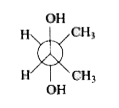Which one of the following is most stable?




The correct Answer is:A
To determine which of the given conformations is the most stable, we need to analyze the interactions present in each conformation. Let's break down the analysis step by step.
1. Identify the Conformations:
- We have four conformations labeled A, B, C, and D. Each conformation has different orientations for the hydroxyl (OH) groups.
2. Analyze Conformation A:
- In conformation A, both OH groups are in the axial position.
- When we draw the hydrogen atoms in this conformation, we notice that there is a hydrogen bonding interaction between one of the axial hydrogens and the oxygen of the OH group.
- This interaction is stabilizing, making conformation A potentially stable.
3. Analyze Conformation B:
- In conformation B, both OH groups are in the equatorial position.
- There are no significant interactions between the OH groups in this conformation, which means it lacks stabilizing or destabilizing interactions.
4. Analyze Conformation C:
- In conformation C, one OH group is in the axial position and the other is in the equatorial position.
- The axial OH group experiences 1,3-diaxial repulsion with the axial hydrogens, leading to destabilizing interactions. This makes conformation C less stable.
5. Analyze Conformation D:
- In conformation D, one OH group is axial and the other is equatorial, similar to conformation C.
- However, there are no significant interactions present in this conformation either, which means it also lacks stabilizing interactions.
6. Compare Stability:
- Conformation A has stabilizing hydrogen bonding interactions.
- Conformations B and D have no interactions, while conformation C has destabilizing interactions.
- Therefore, conformation A is the most stable due to the presence of hydrogen bonding.
Conclusion:
The most stable conformation among the given options is Conformation A, which has hydrogen bonding interactions.
---
- We have four conformations labeled A, B, C, and D. Each conformation has different orientations for the hydroxyl (OH) groups.
- In conformation A, both OH groups are in the axial position.
- When we draw the hydrogen atoms in this conformation, we notice that there is a hydrogen bonding interaction between one of the axial hydrogens and the oxygen of the OH group.
- This interaction is stabilizing, making conformation A potentially stable.
- In conformation B, both OH groups are in the equatorial position.
- There are no significant interactions between the OH groups in this conformation, which means it lacks stabilizing or destabilizing interactions.
- In conformation C, one OH group is in the axial position and the other is in the equatorial position.
- The axial OH group experiences 1,3-diaxial repulsion with the axial hydrogens, leading to destabilizing interactions. This makes conformation C less stable.
- In conformation D, one OH group is axial and the other is equatorial, similar to conformation C.
- However, there are no significant interactions present in this conformation either, which means it also lacks stabilizing interactions.
- Conformation A has stabilizing hydrogen bonding interactions.
- Conformations B and D have no interactions, while conformation C has destabilizing interactions.
- Therefore, conformation A is the most stable due to the presence of hydrogen bonding.
The most stable conformation among the given options is Conformation A, which has hydrogen bonding interactions.
Similar Questions
Knowledge Check
Which one of the following is the most stable conformer?
A B
B C
C D
D
Which of the following ions is most stable ?
ACH3CH2+CH2BCH3+CHCH2CH3C(CH3)3C+D(CH3)3+C.CH2
Which of the following is most stable Carbocation?
View SolutionWhich of the following is the most stable ecosystem?
View SolutionWhich of the following is most stable ecosystem ?
View SolutionWhich of the following is the most stable cycloalkane ?
View SolutionWhich of the following is most stable carbocation?
View SolutionWhich of the following is the most stable species ?
View Solution
